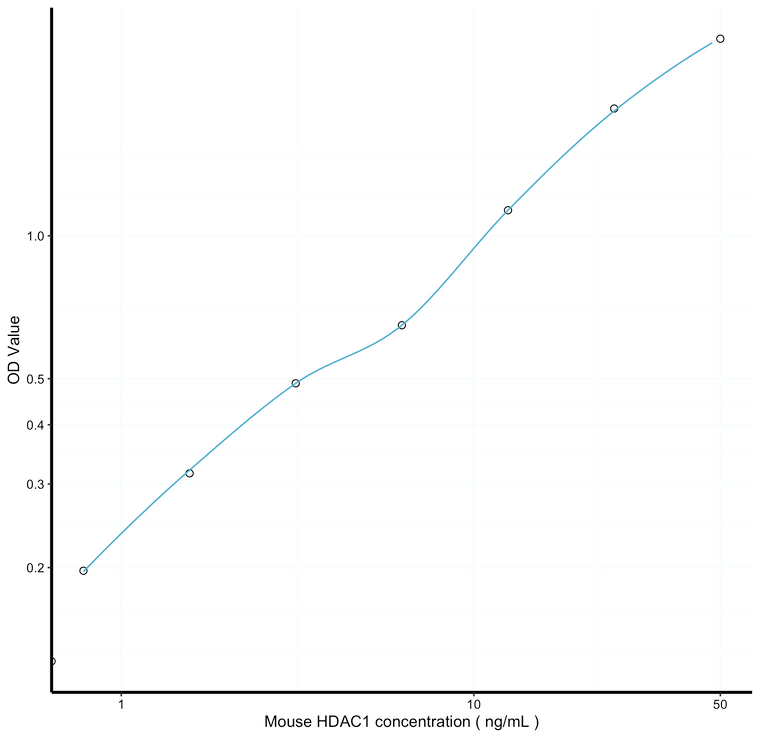| Applications: |
ELISA |
| Reactivity: |
Mouse |
| Note: |
STRICTLY FOR FURTHER SCIENTIFIC RESEARCH USE ONLY (RUO). MUST NOT TO BE USED IN DIAGNOSTIC OR THERAPEUTIC APPLICATIONS. |
| Sensitivity: |
0.21ng/mL |
| Detection Limit: |
0.781-50ng/mL |
| Short Description: |
This HDAC1 Sandwich ELISA Kit, Ready-To-Use is an in-vitro enzyme-linked immunosorbent assay for the measurement of samples in mouse tissue homogenates, cell lysates or other biological fluids.. |
| Storage Instruction: |
The whole kit may be stored at-20°C for up to 12 months from receipt. An unopened kit may be stored in the fridge at 2-8°C for up to 6 months. Once opened store individual kit contents according to components table provided with the kit. |
| Assay Time: |
3 hrs |
| Gene Symbol: |
Hdac1 |
| Gene ID: |
433759 |
| Uniprot ID: |
HDAC1_MOUSE |
| Immunogen Region: |
Ready-To-Use |
| Sample Type: |
tissue homogenates, cell lysates or other biological fluids. |
| Tissue Specificity | Widely expressed with higher levels in thymus and testis and lower levels in liver. Present in muscle (at protein level). |
| Post Translational Modifications | Sumoylated on Lys-444 and Lys-476.which promotes enzymatic activity. Desumoylated by SENP1. Phosphorylation on Ser-421 and Ser-423 promotes enzymatic activity and interactions with NuRD and SIN3 complexes. Phosphorylated by CDK5. Ubiquitinated by CHFR and KCTD11, leading to its degradation by the proteasome. |
| Function | Histone deacetylase that catalyzes the deacetylation of lysine residues on the N-terminal part of the core histones (H2A, H2B, H3 and H4). Histone deacetylation gives a tag for epigenetic repression and plays an important role in transcriptional regulation, cell cycle progression and developmental events. Histone deacetylases act via the formation of large multiprotein complexes. Acts as a component of the histone deacetylase NuRD complex which participates in the remodeling of chromatin. As part of the SIN3B complex is recruited downstream of the constitutively active genes transcriptional start sites through interaction with histones and mitigates histone acetylation and RNA polymerase II progression within transcribed regions contributing to the regulation of transcription. Also functions as a deacetylase for non-histone targets, such as NR1D2, RELA, SP1, SP3, STAT3 and TSHZ3. Deacetylates SP proteins, SP1 and SP3, and regulates their function. Component of the BRG1-RB1-HDAC1 complex, which negatively regulates the CREST-mediated transcription in resting neurons. Upon calcium stimulation, HDAC1 is released from the complex and CREBBP is recruited, which facilitates transcriptional activation. Deacetylates TSHZ3 and regulates its transcriptional repressor activity. Deacetylates 'Lys-310' in RELA and thereby inhibits the transcriptional activity of NF-kappa-B. Deacetylates NR1D2 and abrogates the effect of KAT5-mediated relieving of NR1D2 transcription repression activity. Component of a RCOR/GFI/KDM1A/HDAC complex that suppresses, via histone deacetylase (HDAC) recruitment, a number of genes implicated in multilineage blood cell development. Involved in CIART-mediated transcriptional repression of the circadian transcriptional activator: CLOCK-BMAL1 heterodimer. Required for the transcriptional repression of circadian target genes, such as PER1, mediated by the large PER complex or CRY1 through histone deacetylation. In addition to protein deacetylase activity, also has protein-lysine deacylase activity: acts as a protein decrotonylase and delactylase by mediating decrotonylation ((2E)-butenoyl) and delactylation (lactoyl) of histones, respectively. |
| Protein Name | Histone Deacetylase 1Hd1Protein Deacetylase Hdac1Protein Deacylase Hdac1 |
| Database Links | Reactome: R-MMU-1538133Reactome: -MMU-201722Reactome: -MMU-2173795Reactome: -MMU-3214815Reactome: -MMU-350054Reactome: -MMU-3769402Reactome: -MMU-4551638Reactome: -MMU-6804758Reactome: -MMU-73762Reactome: -MMU-8936459Reactome: -MMU-8943724Reactome: -MMU-9022692Reactome: -MMU-9701898Reactome: -MMU-9824594Reactome: -MMU-9825892Reactome: -MMU-983231 |
| Cellular Localisation | Nucleus |
| Alternative ELISA Names | Histone Deacetylase 1 ELISA kitHd1 ELISA kitProtein Deacetylase Hdac1 ELISA kitProtein Deacylase Hdac1 ELISA kitHdac1 ELISA kit |
| output | |
Information sourced from Uniprot.org
12 months for antibodies. 6 months for ELISA Kits. Please see website T&Cs for further guidance







